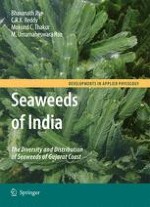India has 7,500 km of coastline with diverse habitats and rich biota. Coastal ecosystems, unfortunately, are experiencing wide range of pressures due to siltation, eutrophication, coastal development, aquaculture and climate change. Those species that adapt to these pressures will expand their living boundaries while others may fade away. Accordingly, the study of coastal biodiversity is of great concern globally and constitutes an important element of global change research. Gujarat has 1,600 km of coastline, reportedly with rich diversity of seaweeds. Previously published accounts on seaweed biodiversity were mainly in the form of checklists, the earliest among these being the checklist of Krishnamurthy and Joshi prepared in the early 1970s. The more recent checklists are based almost entirely on secondary information. The present book entitled Seaweeds of India – The Diversity and Distribution of Seaweeds of Gujarat Coast is a timely publication based wholly on primary data. Data were collected through extensive and systematic ? eld studies conducted by the authors during different seasons over a three year period. The authors collected nearly 200 species of seaweeds belonging to 100 genera of Chlorophyta, Phaeophyta and Rhodophyta. Twenty-four of the species are new to Gujarat coast and three are new to Indian waters. The book contains high-quality images of the different species in their existing habitats. Brief taxonomical descriptions, together with information on ecology, distribution, seasonality and abundance, are covered for each of the species.
